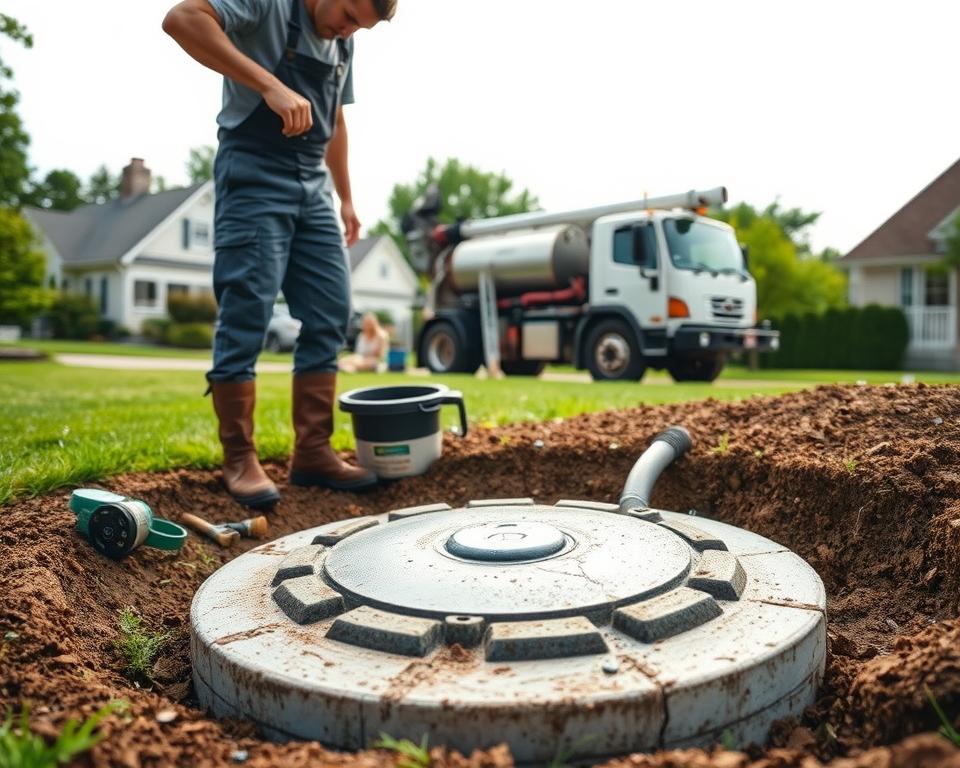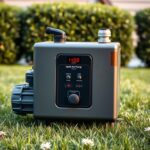RV Wastewater Pump Guide: Vital Upkeep Recommendations
Did you ever ponder the operation of your RV’s sewer system? Grasping the details of your RV sewer pump can prevent mishaps, improving your road trips. It’s all about overseeing waste efficiently and warding off foul smells. In this handbook, you’ll discover essential maintenance tips for black water pumping service. Each designed to preserve your sewer network’s best operation.
Learning About Your RV Sewage Pump Network
The recreational vehicle waste pump network is vital for waste management, making outdoor stays more enjoyable. It comprises two primary tanks: the sewage holding tank for bowel output and the grey-water reservoir for water from sinks and showers. Telling apart these tanks is important to stop clogs and keep your RV operating smoothly.
An RV macerator pump is a common selection for refuse disposal. It shreds solid waste into minute particles, easing disposal. Alternatively, you can choose, a classic RV pump is available. It effectively moves waste without pulverizing, for those seeking a simpler option.
Knowing your RV’s waste pump setup is vital to stopping problems and ensuring clean inspections. Operating the system correctly can prevent messes, boosting your outdoor adventures.
Value of Regular Service
Maintaining your RV sewage disposal pump is imperative for a seamless trip. Without proper maintenance, you may encounter odors, clogs, or backups. These glitches can ruin your road trips.
Consistent servicing stop such problems and extend your system’s life. By inspecting hoses and seals, you enhance efficiency. A properly cared-for RV sewage pump ensures hygienic operation, letting you enjoy nonstop trips.
Regular servicing also yields financial savings over time. Lack of care can cause costly breakdowns, requiring pricey repairs. Putting resources into regular maintenance keeps your motorhome in optimal state, preserving money long term.
How Frequently to Service Your RV Septic Tank?
Knowing the right time to pump your RV Septic Tank is key for its upkeep. It’s suggested to pump every three to five days during use. For weekend journeys, pumping on return may work fine.
Frequency depends on different variables. Tank size and usage level are critical. Ideally pump when it reaches 66% capacity. This helps support smooth flow and stop clogs.
Checking your RV tank fill level is key for a smooth journey. Manage your camper’s waste to stop issues while traveling.

Optimal Methods for Tank Disposal
Safely purging RV tanks is vital for your motorhome’s cleanliness and functionality. Begin with the black tank to let the grey tank liquid rinse leftover solids. This method ward off clogs and ensures seamless flow.
Select a premium sewer hose for disposal. A heavy-duty hose stops leaks and secures connections. Include a tank rinser for a thorough rinse, using water pressure to remove lingering waste, enhancing cleanliness.
Comprehensive emptying prevents residue buildup, warding off foul odors and potential issues. To maintain an effective sewage system in your motorhome, observe these guidelines:
- Always add a tank treatment after emptying to keep odors at bay and break down waste.
- Monitor tank levels to avoid spills.
- Check your RV sewer pump often for clogs and wear.
- Deep rinse tanks each month or twice monthly, even during infrequent outings.
Adopting these techniques enhances your sewage system’s lifespan and efficiency, ensuring smooth journeys.
Preventing Odors and Clogs
For a nice outing, keeping odors at bay is vital. Maintain adequate water level to aid in breaking down waste, warding off unpleasant odors. Also, choosing camper-safe TP helps prevent clogs, keeping the system running smoothly.
For better sewage management in campers, try enzymatic solutions. These process sludge thoroughly, reducing effort. Check the vent line often to keep air moving freely in the plumbing system.
Careful waste habits is essential to avoiding tank issues. Refrain from disposing of wipes, feminine products, and paper towels. These non-compostable materials can cause major clogs. Adhering to these guidelines helps maintain a more sanitary camping environment.
Maintenance Advice for RV Sewage Pumps
Servicing your RV waste pump network is key for trouble-free travels. Check valve seal integrity often to prevent leaks. Worn seals can cause accidents, harming your RV.
To eradicate odors and maintain cleanliness, sanitizing is key. Carry out intensive cleans quarterly to curb scale formation, ensuring the system works efficiently. These steps are critical for maintaining a mobile macerator, promoting longevity and smooth service.
Oiling valve mechanisms is another important task. It helps stop leaks and improve functionality. Checking sensor accuracy is key for accurate readings, preventing spillovers and unexpected pump issues. Maintaining vigilance makes your RV adventures more sanitary and more enjoyable.
When to Call in a Pro for Pump-Out
Identifying septic problems ahead can save you from bigger headaches. A primary clue you need a pro pump service is delayed emptying. When sinks and toilets take longer to clear, it often points to clogs. It suggests your system may be jammed.
Persistent odors are another clear sign of sewage troubles. Stench that won’t go away despite cleaning suggest trapped waste. It’s crucial to examine the elbow trap when dumping waste. Remaining waste visibility signals it’s time for pro maintenance.
Technicians employ water-jet systems to dismantle stubborn blockages efficiently. Ignoring these warnings can lead to major problems. Therefore, it’s imperative to seek help immediately when issues arise.
| Signs of Sewage Issues | Suggested Steps |
|---|---|
| Delayed Drainage | Look for blockages; schedule pro maintenance |
| Persistent Odors | Check vents; contact pro service |
| Visible Waste Residue | Call pro for deep cleanse |
Choosing the Right RV Macerator Pump
When picking an RV macerator pump, evaluate its volume handling, build quality, and compatibility with your RV’s size. A reliable macerator is critical for effective waste grinding. This is especially important for RVs requiring regular emptying. High-end pumps optimize sewage handling, ensuring a smoother RV lifestyle.
A range of options cater to specific demands. For an informed decision, focus on these key factors:
- Capacity: Ensure the pump can handle your RV’s waste output.
- Durability: Choose pumps with robust construction.
- Ease of Use: Prefer straightforward, easy-to-use models.
- Compatibility: Check plumbing compatibility.
Carefully considering options when choosing an RV macerator pump improves travel enjoyment and ensures effective waste management.
Troubleshooting Your RV Sewer Pump
Accurate diagnosis for your RV sewer pump is essential in rectifying common sewage issues before they worsen. If you notice slow drainage, unplanned backflows, or persistent odors, act quickly. These are obvious indicators of malfunction requiring attention.
First inspect the pump, its connections, and hoses. Look for any clogs that could slow flow. Ensure inlet and outlet fittings are properly connected. Also, verify the pump’s power supply for stability.
If basic checks fail to reveal the issue, listen to the pump’s sound. A unit that’s abnormally loud or abnormally quiet may have internal damage. Also, inspect for leaks, as these can compound sewage problems. With these troubleshooting steps, many RV owners identify and fix issues early, avoiding costly repairs.
Ongoing Care for Your RV Pump
For extended service life, commit to regular sewer pump upkeep. Clean the system consistently to prevent clogs. Implement and adhere to a maintenance routine, keeping everyone informed of their roles. This considerably extends your waste system’s lifespan.
Training yourself and others on appropriate use is essential. This avoidss issues and fosters shared responsibility. The result benefits both users and the sewer system.
- Routine inspection of hoses and connections
- Cleaning filters regularly
- Book expert service once a year
- Select suitable additives
Abiding by these practices boosts your camper’s sewage system’s durability and keeps it healthy, making travels more comfortable.
The Bottom Line
Caring for your RV sewer system diligently is vital for smooth camping adventures. Regular attention to RV sewer system maintenance markedly cuts problem risks, letting you focus in the journey. By understanding your system and applying reliable sewage methods, your trips will be free of waste management woes.
Implementing the key tips from this guide boosts RV waste management and uplifts your travel comfort and safety. Maintain peak performance by following best upkeep practices and resolving potential issues promptly.
Staying vigilant about your RV sewer system pays off. It provides homely comforts while exploring. Cheers to joyous and untroubled journeys!
FAQ
How do I know when it’s time to pump my RV Septic tank?
Pump the RV Septic tank when it hits 66% capacity.
What’s the difference between the black tank and the grey tank?
The black tank holds toilet waste. Whereas, the grey tank collects water from sinks and showers.
How often should I maintain my RV sewer pump system?
Check seals, sanitize, and clean quarterly.
Recommended products for RV sewer pump maintenance?
Use enzyme-based treatments safe for RVs.
How to keep my camper’s sewer lines clog-free?
Use only RV-safe toilet paper.
What signs indicate I need professional RV pump-out?
Blockages, foul scents, or tank overflow warrant expert service.
How can I improve my RV macerator pump’s efficiency?
Select a correctly sized pump for your RV.
What should I check during a deep clean of my RV sewer system?
Inspect all connections and hoses.
Guidelines for extended RV pump care?
Train users on proper disposal.
What’s the pumping interval for frequent RV use?
Schedule pump-outs every 3–5 days.


